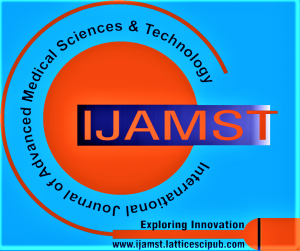![]()
Evaluate the Effects of Gamma Radiation (16 Sv/h), Neutron Radiation (3 Sv/h), and a Mixed Radiation Field on the Structural and Biophysical Properties of Bones
Mohamed S. Nasr Eldin1, Ahmed. A Emara2, Hala M. Ahmed3
1Dr. Mohamed S. Nasr Eldin, Department of Radiology and Medical Imaging, Faculty of Applied Health Sciences Technology, October 6 University, 6th of October City, Egypt.
2Dr. Ahmed. A Emara, Department of Radiology and Medical Imaging, Faculty of Applied Health Sciences Technology, October 6 University, 6th of October City, Egypt.
3Prof. Dr. Hala M. Ahmed, Department of Medical Biophysics: Biomedical Equipment, Faculty of Applied Health Sciences Technology, October 6 University, 6th of October City, Egypt.
Manuscript received on 11 August 2025 | First Revised Manuscript received on 02 September 2025 | Second Revised Manuscript received on 17 September 2025 | Manuscript Accepted on 15 October 2025 | Manuscript published on 30 October 2025 | PP: 11-16 | Volume-5 Issue-6 October 2025 | Retrieval Number:100.1/ijamst.F305105061025 | DOI: 10.54105/ijamst.F3051.05061025
Open Access | Editorial and Publishing Policies | Cite | Zenodo | OJS | Indexing and Abstracting
© The Authors. Published by Lattice Science Publication (LSP). This is an open-access article under the CC-BY-NC-ND license (http://creativecommons.org/licenses/by-nc-nd/4.0/)
Abstract: Background: Ionizing radiation, including gamma and neutron radiation, can adversely affect bone structure, mineralization, and tissue integrity. While individual effects of gamma or neutron exposure have been studied, comparative analyses of their isolated and combined impacts on bone’s structural and biophysical properties remain limited. Objective: This study aimed to evaluate the effects of gamma radiation (16 μSv/h), neutron radiation (3 μSv/h), and combined exposure on bone mineral content, collagen synthesis, cytokine levels, biomechanical properties, and histopathological changes in rats. Materials and Methods: Eighty male albino rats were divided into four groups: control (no radiation), gamma-exposed, neutron-exposed, and combined gamma-neutron exposure. Bone calcium was measured using atomic absorption spectrophotometry, and collagen content was quantified via hydroxyproline-based colourimetric assays. Serum interleukin-1β (IL-1β) and tumour necrosis factor-alpha (TNF-α) levels were determined using ELISA. Biomechanical properties of tibia bones, including tensile strength, stiffness, and energy absorption, were assessed through stress-strain analysis and cyclic loading. Skin and mammary tissues were examined histologically using hematoxylin and eosin staining. Results: Radiation exposure reduced calcium and collagen content, with the most pronounced effects observed in neutron and combined radiation groups. TNF-α levels were significantly elevated in irradiated rats, while IL-1β showed a non-significant upward trend, indicating an inflammatory response. Biomechanical analysis revealed reduced bone strength and increased energy dissipation, suggesting microstructural damage. Histological examination confirmed inflammation, necrosis, and impaired regenerative capacity, particularly in the combined radiation group. Conclusion: Gamma and neutron radiation, both individually and in combination, hurt bone mineralisation, collagen synthesis, inflammatory cytokine balance, and biomechanical integrity. These findings underscore the susceptibility of skeletal tissue to ionizing radiation and highlight the importance of protective strategies in clinical, occupational, and spaceflight environments. Future research should explore interventions targeting oxidative stress and inflammation to mitigate radiation-induced musculoskeletal damage.
Keywords: Gamma Radiation; Neutron Radiation; Bone Biomechanics; Collagen; Calcium; Cytokines; Histopathology.
Scope of the Article: Cancer Research
